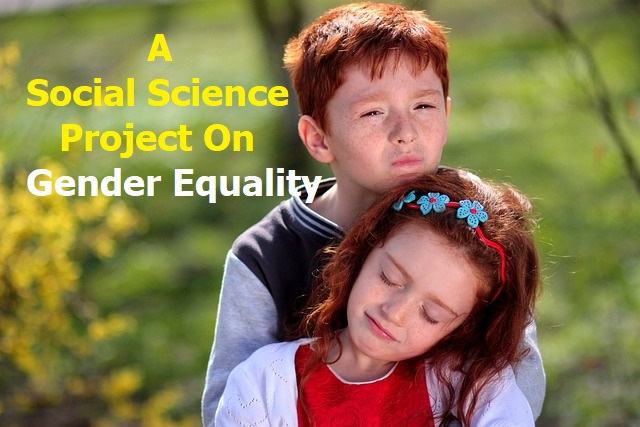Social Science Project On Gender Stereotypes and Socialization
How to write a project on gender stereotypes and socialization. In this article we are going to focus on the influence of gender stereotypes and socialization on individuals’ roles and expectations. We shall try to explore how these stereotypes contribute to gender inequality. Also, suggest ways to challenge and overcome them in various spheres of life, including media, parenting, and social institutions. This project on gender stereotypes and socialization will also analyze the existing gender disparities in education and exploring strategies to promote gender equality in educational settings. It involves studying access to education, enrollment rates, curriculum biases, and the impact of gender-sensitive teaching methods. So, let’s begin the Project on gender stereotypes and socialization.
Introduction:
Gender stereotypes and socialization play a significant role in shaping individuals’ roles, behaviors, and expectations based on their gender.
These societal norms and expectations often reinforce gender inequality and limit individuals’ opportunities and choices.
This project aims to explore the influence of gender stereotypes and socialization on various spheres of life.
Additionally, it seeks to identify strategies and approaches to challenge and overcome these stereotypes, fostering a more equal and inclusive society.
Gender stereotypes and socialization play a significant role in shaping our perceptions and expectations of individuals based on their gender.
From a young age, children are exposed to societal norms and expectations regarding appropriate behaviors, interests, and roles for males and females.
These stereotypes are reinforced through various socialization agents such as family, education, media, and peer groups.
Stereotypes assign certain characteristics to each gender, often reinforcing traditional gender roles and perpetuating inequality.
Boys are encouraged to be strong, assertive, and interested in activities like sports and technology.
On the other hand, girls are expected to be nurturing, gentle, and interested in domestic tasks or artistic pursuits.
These stereotypes limit individuality and can have negative consequences.
They discourage individuals from exploring their full range of interests and abilities.
Examples Of Gender Stereotypes
Firstly, Socialization through gender stereotypes can lead to unequal opportunities and expectations in various aspects of life, including education, career
choices, and personal relationships.
Secondly, challenging these stereotypes is crucial for promoting gender equality and allowing individuals to express themselves authentically.
Moreover, It requires creating inclusive environments that encourage individuals to break free from societal expectations. regardless of gender.
Here are a few examples of gender stereotypes.
Occupational roles:
You will find gender stereotypes often assign specific professions to men or women.
This is because they assume that women are better suited for caregiving roles.
For example nursing, teaching, taking care of family and children at home.
On the other hand, they assume that men are more suited for leadership positions like engineering, business and other outdoor services.
Appearance expectations:
Today, our society often imposes rigid beauty standards on women.
Moreover, believes that a girl or women should be slim, young, white in color and pretty attractive.
Men, on the other hand, may face pressure to conform to ideals of muscularity, tall with physical strength and good earning.
Parenting roles:
People in the society are with this mind set that women are inherently more caring and better suited to care for children.
Whereas, males are supposed to be less involved in parenting and to be more concerned with providing financial support.
Emotional expression:
Further, the society often expect that males should be stern and emotionless.
Whereas, women are expected to be more expressive reinforces the notion that men should not overtly show emotions like sadness or vulnerability.
Hobbies and interests:
People believe that certain activities and hobbies are often associated with a specific gender.
Assuming that women are more interested in cooking, fashion, or arts.
Whereas, men are expected to be interested in sports, technology, or cars.
Therefore such stereotypes can limit individuals’ choices and perpetuate gender-based divisions.
Influence of Gender Stereotypes and Socialization:
The investigation of gender stereotypes and socialization will be the main emphasis of this study. It will examine how gender roles, behaviors, and characteristics are conveyed and internalized from a young age. Key analysis points are as follows:
Identification of common gender stereotypes and their impact on shaping societal expectations.
Understanding how prevalent gender stereotypes affect society expectations depends on being able to identify them.
Stereotypes that limit people’s potential include those that portray men as powerful and assertive while women as nurturing and docile.
To achieve gender equality and promote inclusive cultures, it is crucial to challenge and destroy these preconceptions.
Exploring how socialization processes within families, schools, and communities perpetuate gender norms?
Gender norms are maintained through examining the socialisation processes that take place in homes, schools, and communities.
Children’s gender-based roles and behaviours are ascribed to them from an early age, which shapes their views and expectations.
Self-perception, job decisions, and interpersonal relationships are impacted by these standards, which are reinforced by family interactions, educational
programmes, and societal messaging.
In order to create circumstances that enable people to transcend traditional gender stereotypes and accept their real selves,
it is essential to recognise and challenge these processes.
Examining the role of media in reinforcing and perpetuating gender stereotypes.
Examining the media’s part reveals how important it is to maintaining and promoting gender stereotypes.
Television programmes, motion pictures, commercials, and online media frequently feature rigid gender roles and representations that stifle individual
expression and uphold social norms.
Men are typically shown as aggressive and powerful, whereas women are frequently objectified and portrayed as submissive and dependent.
These representations affect relationships, aspirations, and self-image in addition to societal standards. In order to challenge and debunk these
stereotypes and promote a more inclusive and equitable media landscape that reflects the complexity and diversity of human experiences, media literacy
and the promotion of diverse, authentic representations are essential.
Analysis of the impact of gender stereotypes on individual identities, self-perception, and aspirations.
Gender stereotypes have a significant impact on people’s identities, perceptions of themselves, and goals.
Individuals frequently succumb to expected gender norms after internalising society expectations, which limits their ability to express themselves and learn
about themselves.
Men may feel pressured to repress their feelings and assert their power, while women may feel forced to prioritise caregiving above job goals.
Because of these prejudices, people may have low self-esteem, feelings of inadequacy, and self-doubt.
Aspirations may also be inhibited because people may refrain from pursuing careers or roles that are seen as “unfit” for people of their gender.
It’s critical to dismantle gender stereotypes in order to promote personal authenticity and empowerment.
Individuals can escape from constricting expectations, pursue their passions, and help create a society where everyone can prosper regardless of gender
by embracing varied identities and advocating for equitable chances.
Challenging Gender Stereotypes in Media:
The second part of this project will examine how the media reinforces and challenges gender stereotypes.
It will examine tactics and programmes meant to encourage more varied and equitable gender representations in the media.
Important topics to be covered include:
Critique of gender portrayals in different forms of media, such as television, films, and advertisements
Deep-seated biases and the continuation of negative stereotypes are revealed when gender representations in various media, such as television, movies,
and commercials, are critically examined.
The idea that women’s value is based exclusively on their beauty is reinforced by the way they are frequently objectified, reduced to objects of desire or
simply accessories.
Men are typically portrayed as strong, dominant, and successful, whereas women are frequently portrayed as submissive, subordinate, and lacking
agency.
These representations not only minimise and restrict women’s roles but also strengthen damaging ideas about what it means to be a man, forcing males
to live up to unattainable ideals of dominance and strength.
Such gender representations perpetuate power disparities, exacerbate body image problems, and limit the variety of identities and goals that people can
have.
Media must be held accountable for promoting more diverse, inclusive, and empowering representations that challenge stereotypes and promote gender
equality.
Examination of the effects of media on shaping gender identities and reinforcing stereotypes.
Media has a tremendous impact on how people define their gender identities and how stereotypes are reinforced.
The construction of societal standards and ideas of femininity and masculinity is heavily influenced by the media.
Individuals’ self-perception and identification are greatly influenced by ongoing exposure to gendered images, storylines, and role models in films,
television programmes, commercials, and social media platforms.
The idea that particular behaviours, appearances, and roles are acceptable or expected based on one’s gender is frequently reinforced through media.
This can result in these preconceptions being internalised, limiting self-expression, and contributing to the marginalisation of people who don’t fit the
mould.
Promoting more inclusive and empowering narratives that allow for a wider range of gender identities and manifestations requires challenging and
diversifying media representations.
Analysis of media campaigns, initiatives, and policies aimed at challenging gender stereotypes
Promoting equality and eradicating harmful norms require media campaigns, initiatives, and policies that strive to dispel gender stereotypes.
They frequently work to dismantle strict gender norms, confront prejudices, and promote diversity. Campaigns showcasing diverse and strong
representations of women, encouraging positive masculinity, and showcasing people who challenge conventional gender stereotypes are a few examples
of such initiatives.
Initiatives emphasize media literacy, enlightening people about stereotypes’ effects, and fostering critical thinking.
Promoting gender equality in media portrayal and addressing harmful practices are the goals of policy initiatives.
By dispelling misconceptions, these initiatives support a more diverse media environment, encourage people to embrace their true selves, and advance a
culture that values gender equality and diversity.
Case studies of successful examples of media content challenging gender norms
Like a Girl
The Always “Like a Girl” campaign aimed to dispel gender stereotypes by drawing attention to the negative connotations of acting “like a girl” and giving
females the power to reframe the term in a positive light.
It attempted to alter society beliefs and increase the self-confidence of girls.
Wonder Woman
A powerful, self-reliant female superhero serving as the main character in Patty Jenkins‘ “Wonder Woman” smashed down barriers.
With a strong and empowering representation of a female lead,
it encouraged fans and disproved the idea that superheroes are primarily male.
Transforming Parenting Practices:
The final segment will concentrate on how parenting affects whether gender stereotypes are upheld or challenged.
It will look at methods and tactics for advancing gender equality within the family. Investigative focus areas include:
Examination of how parenting practices and attitudes contribute to the transmission of gender stereotypes.
Gender stereotypes are largely spread through parenting behaviours and attitudes.
Parents unknowingly promote society norms by designating particular toys, activities, and duties based on gender.
Furthering the perpetuation of these preconceptions is the practise of modelling traditional gender norms and expectations through one’s own actions and
language.
Breaking the loop by opposing these behaviours and encouraging gender-neutral parenting will enable kids to freely explore their identities and grow
beyond strict gender standards.
Analysis of gendered expectations and roles within the family and their impact on children’s development.
Gendered expectations and roles within the family have a profound impact on children’s development.
When children witness traditional gender roles, such as women as caregivers and men as breadwinners,
it shapes their perceptions of gender and influences their own aspirations and behaviors.
These expectations can limit their potential, reinforce stereotypes, and hinder their ability to explore diverse interests and identities.
Creating an inclusive family environment that challenges gender norms allows children to develop authentically and fosters their well-rounded growth and
self-expression.
Exploration of parenting interventions, educational programs, and support systems that challenge traditional
gender norms.
To disrupt ingrained gender norms, parenting interventions, educational initiatives, and support networks are being created.
By encouraging kids to explore a variety of interests and identities, these organisations hope to give parents tools and advice for fostering gender equality.
While support services provide a safe environment for people and families to question and relearn conventional gender norms, educational programmes
encourage critical thinking about gender stereotypes.
These interventions attempt to create more inclusive and equitable environments where children can thrive by raising awareness and offering tools for
change.
Case studies highlighting successful examples of parenting practices promoting gender equality and breaking
gender stereotypes.
The gender equality-focused Swedish parenting approach has been successful in challenging traditional gender roles.
By refraining from gender-specific activities, toys, and apparel, Swedish parents deliberately encourage gender-neutral parenting.
This strategy strives to give kids the same chances, regardless of their gender, to explore their interests and abilities, promoting a more inclusive and
egalitarian society.
Gender stereotypes in the toy industry have been significantly contested thanks to the Let Toys Be Toys movement in the UK.
By urging shops to cease classifying toys as “for girls” or “for boys,” they support a wider variety of toys that are appropriate for all kids.
By removing gendered marketing, this programme tries to give kids the freedom to choose according to their interests rather than cultural norms.
Overcoming Gender Stereotypes in Social Institutions:
The fourth section will address the role of social institutions, such as schools, workplaces, and community organizations,
in challenging gender stereotypes and fostering equality. Key elements to be covered are:
Firstly, study of how social institutions affect whether gender norms and expectations are reinforced or challenged.
Secondly, analysis of programs, actions, and procedures in educational institutions that support gender equality and dispel preconceptions.
Thirdly, investigation of workplace interventions, diversity and inclusion initiatives, and gender equality-promoting laws.
Lastly, case studies of neighborhood groups and movements fighting to remove gender stereotypes and advance inclusivity.
Gender Disparities in Education
In many regions of the world, gender discrepancies in education are still a problem.
Girls and women continue to confront several obstacles that prevent them from accessing high-quality education, despite great advances in advancing
gender equality in education.
The chances that girls have to go to school are disproportionately impacted by factors like cultural norms, poverty, early marriage, discrimination, and a
lack of resources.
These differences have long-term effects on both girls’ personal growth and societal advancement in addition to depriving them of their fundamental
access to an education.
It takes coordinated efforts to address systemic disparities, ensure equitable access to educational opportunities, promote gender-sensitive curriculum,
and combat negative gender stereotypes in order to close the gender gap in education. Societies can unleash the full potential of girls and women via
education, resulting in a more equitable world.
By empowering girls and women through education, societies can unlock their full potential and create a more equitable and prosperous future for all.
Exploring Strategies to Promote Gender Equality in Educational Settings
Eliminate gender bias in curriculum and teaching materials:
Make sure that textbooks, reading materials, and educational tools question gender stereotypes, represent various viewpoints, and show men and women
in roles that aren’t traditional.
This supports inclusive learning environments and offers all students the same opportunity.
Encourage girls’ participation in STEM fields:
Develop programs that actively involve girls in STEM fields including science, technology, engineering, and Maths. In order to do this, mentorship
programs may be made available, successful women in STEM sectors may be highlighted, workshops and extracurricular activities may be planned,
and programs for mentoring may be made available.
Promote gender-inclusive teaching methods:
Firstly, encourage teachers to use a variety of teaching techniques.
Techniques that accommodate various learning preferences and foster an inclusive learning environment.
Moreover, this includes supporting equal participation, encouraging collaborative learning, and making sure all students, regardless of gender, feel
appreciated and encouraged.
Provide gender-sensitive career guidance and counseling:
Initially, provide gender-neutral career guidance that offers all students equal access to information and support.
Moreover, encourage students to consider a variety of careers without limiting their possibilities due to gender bias or cultural expectations.
Implement anti-bullying and harassment policies:
It is important to create and enforce strong standards to prevent harassment and bullying on the basis of gender in school environments.
Therefore, create safe and welcoming environments for all children.
To succeed academically and socially.
Impact of Gender-Sensitive Teaching Methods
Inclusive learning environment: Gender-sensitive teaching methods create an inclusive classroom environment where all students feel valued and respected, irrespective of their gender. For example, incorporating group discussions and collaborative activities allows students to engage with diverse perspectives and learn from each other’s experiences.
Challenging stereotypes:
Traditional gender stereotypes are actively contested and dismantled through gender-sensitive educational strategies.
The variety of careers, pastimes, and interests that are open to all pupils can be highlighted by teachers using examples and case studies that highlight
people who have defied gender norms.
Encouraging equal participation:
in the classroom teachers must use gender-sensitive teaching techniques.
Girls and boys must be encouraged to participate equally in discussions and activities.
However, to ensure equitable participation,
teachers can use techniques like random selection for responding questions or allocating group responsibilities.
Addressing diverse learning needs:
Firstly, it is important to understand that gender-sensitive teaching strategies take into account the fact that each student has unique learning requirements
that may not be based purely on their gender.
Therefore, to accommodate various learning styles, teachers can use a number of teaching strategies.
Moreover, every student must get the chance to achieve academic success.
Empowering all students:
It is important that all students benefit from gender-sensitive teaching strategies.
This is because they foster self-assurance, critical thinking, and self-expression.
Moreover, teachers can inspire children to question gender norms and explore their special talents and by providing a safe and encouraging environment.
For instance, adding literature that is inclusive and has compelling, varied characters might encourage children to feel empowered.
Conclusion:
In conclusion, socialization and gender stereotypes both have a substantial impact on how people perceive their prospects and behave. Through the course of this study, we have investigated the different ways that society limits people’s potential and upholds inequality by placing inflexible expectations on them based on their gender. However, by comprehending and dispelling these myths, we may work towards a society that is more egalitarian and inclusive. In order to move away from rigid gender standards and towards one that is more flexible and tolerant, people must be empowered to express their true selves through education, open communication, and dialogue. We can create a society where everyone is free to realize their full potential, regardless of gender, by destroying gender stereotypes and supporting various portrayals.
The conclusion also provides recommendations for policymakers, educators, parents, and individuals to actively contribute to challenging gender stereotypes and promoting gender equality in their respective spheres.





0 Comments